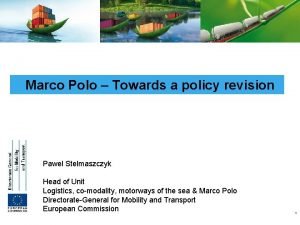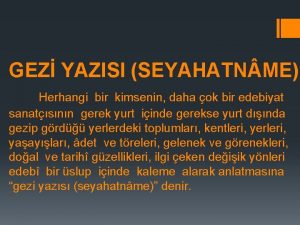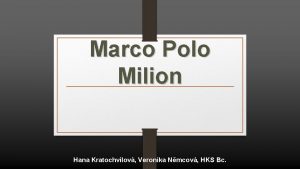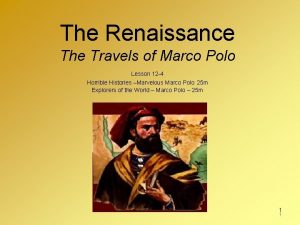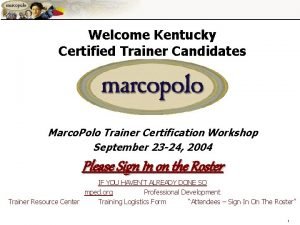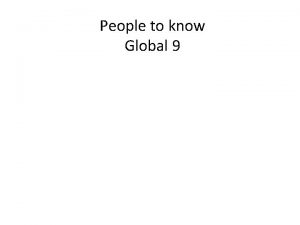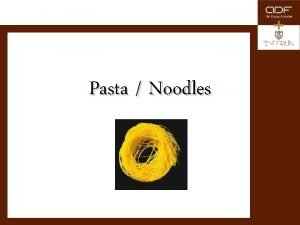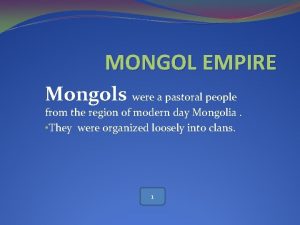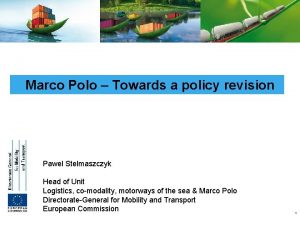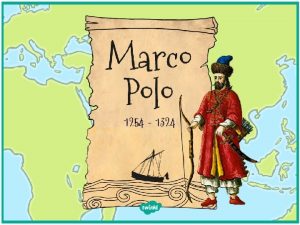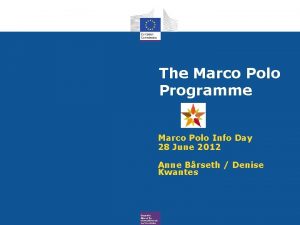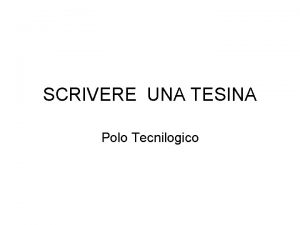Marco Polo Towards a policy revision Pawel Stelmaszczyk
















- Slides: 16

Marco Polo – Towards a policy revision Pawel Stelmaszczyk Head of Unit Logistics, co-modality, motorways of the sea & Marco Polo Directorate-General for Mobility and Transport European Commission 1

MARCO POLO - MARKET CONTEXT ● annual freight transport growth (2. 8% pa) higher than overall economic growth (2. 4%) ● road: continues to gain market share compared to all other transport modes ● ● ● short sea shipping: strong, sustained dynamism inland waterway: considerable unexploited potential rail: halted relative decline since 2001, higher increase in states with early market opening ● environmental impacts of transport remain high: 1% of GDP, road congestion cost an additional 1% of GDP 2

MARCO POLO – POLITICAL CONTEXT ● ● 2001: Transport White Paper: intermodality as key concept 2003: MARCO POLO programme (2003 -2006) to support intermodal services and alternatives to road-only transport ● 2006: Keep Europe Moving - Review of 2001 White Paper Co-modality: promotion of optimal use and integration of modes, and logistics: using existing capacities more efficiently, cutting costs, reducing environmental impact ● ● ● 2006: Marco Polo II (2007 -2013): Enlarged scope and budget 2008: Greening of transport: Internalisation of external costs 2009: Communication on future of transport 3

MARCO POLO II ● ● ● Continuing Marco Polo I with larger scale and scope Duration: 2007 -2013 Budget: 450 M € Larger geographical scope – close third countries 5 action types; 2 new innovative ones: ● Motorways of the Sea ● Traffic Avoidance Actions ● Since 1. 3. 08 the Programme is managed by the Executive Agency for Competitiveness and Innovation (EACI) 4

MARCO POLO II – Key Features ● objective: shift/avoid international increase in road freight off the road (road freight transport estimated growth of 20. 5 billion tkm/year over the period 2007/2013) ● ● ● risk funding, business-driven all segments of international freight (except air) services only <> no research, studies or (core) infrastructure 5

MARCO POLO II – Key Features ● ● Legal entity: commercial undertakings only (private or public) Eligible for participation: ● EU-27 Member States + “close third countries” ● Eligible for EC-funding: ● EU-27 Member States + EFTA & EEA States after conclusion of specific agreement + Candidate and close third countries after Memoranda of Understanding ● European dimension ● international routes (Member States and close third countries) ● now ony 1 undertaking 6

MARCO POLO II – Key Features ● Eligible costs: only costs incurred after submission date of the application – even if the action starts earlier ● No profit allowed: during the (accumulated) years for funding ● Viability: - the project should show profit and continue after MP funding ● No state aid allowed: maximum combined public grant allowed = (35% - 50%) 7

MARCO POLO II – Key Features ● No unacceptable distortion of competition: - a detailed justification must be given! ● Credibility essential: proven by letters of intent, good business plan, market study etc. ● ● Financial capacity: last annual financial statement Technical capacity: track records and experience of all partners, CV’s etc. 8

MARCO POLO – OVERALL RESULTS Better budget execution in 2009 9

Basis for Marco Polo revision ● ● Communication on the future of Transport The Commission 2020 Strategy: ●Modernise and decarbonise the EU Transport Sector and promote energy efficiency ● Marco Polo II Regulation – Article 14 ●Communication on the results achieved by the Marco Polo Programmes before drawing up a proposal for a third Marco Polo Programme 10

Marco Polo after 2013: Possible Policy options ● ● ● Marco Polo II continued Extension of the Marco Polo II Fundamental revision of the programme 11

Options for the future (1)? ● Extension of the Scope of the Programme ● Extending the programme to passenger inter-modality? ● Extending the programme to pipeline transport? ● Longer funding periods? ● Taking into account effects of economic crisis ● New financing Instruments? ● Loans? ● Involvement of the EIB? ● New types of actions? 12

Options for the future Possible measures for the(2)? future ● Different funding conditions for each transport mode on the basis of safety, environmental performance and energy efficiency? ● Funding intensity expressed not only in tkm but also in terms of energy efficiency and environmental benefits? ● Product-specific lowering of eligibility thresholds? ● Additional support to SME’s? 13

How to carry on? ● Consistency between Marco Polo, Logistics Action Plan and TEN-T ● TEN-T, Marco Polo, Mo. S policy evaluation and impact assessment: parallel exercises ● ● Input from Marco Polo II mid-term evaluation Support from EACI’s experience of the programme management. 14

Timing ● Spring 2010: Launch of a study on Marco Polo beyond 2013 ● ● Mid 2010: Public consultation ● Mid 2011: Communication and possible legislative proposal Second half 2010: Mid-term evaluation and consultation 15

Thank you for your attention! For further information: http: //ec. europa. eu/dgs/transport/index_en. htm 16
 Where was marco polo born and raised
Where was marco polo born and raised Revision polo
Revision polo Istituto comprensivo marco polo fabriano
Istituto comprensivo marco polo fabriano Marco polo global
Marco polo global Gezi yazısı marco polo
Gezi yazısı marco polo Marco polo milion
Marco polo milion Marco polo fabriano
Marco polo fabriano Marco polo renaissance
Marco polo renaissance Marco polo yahoo
Marco polo yahoo Marco polo liar
Marco polo liar Viaggio di marco polo in cina
Viaggio di marco polo in cina Marco polo liceo linguistico
Marco polo liceo linguistico Marco polo accomplishments
Marco polo accomplishments When was marco polo born and when did he die
When was marco polo born and when did he die Marco polo pasta myth
Marco polo pasta myth Marco polo history
Marco polo history Passive revision
Passive revision

